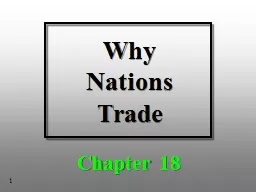

1 Discussion Topics Why trade Absolute advantage Gains from trade 2 Concepts Affecting Trade Absolute advantage exists when one nation can produce goods more cheaply than another nation ID: 781575
Download The PPT/PDF document "Why Nations Trade Chapter 18" is the property of its rightful owner. Permission is granted to download and print the materials on this web site for personal, non-commercial use only, and to display it on your personal computer provided you do not modify the materials and that you retain all copyright notices contained in the materials. By downloading content from our website, you accept the terms of this agreement.
Slide1
Why Nations Trade
Chapter 18
1
Slide2Discussion TopicsWhy trade?Absolute advantageGains from trade
2
Slide3Concepts Affecting TradeAbsolute advantage – exists when one nation can produce goods more cheaply than another nation
Comparative advantage
– ability of a nation to specialize in the production of the good for which it has lowest opportunity costCompetitive advantage – economic competitiveness of a nation reflected in the absolute cost of a given good in a given market at a particular point in time
Pages 359-363
3
Slide4Comparative AdvantageComparative advantage : If one nation is less efficient in the production of a good than another nation, there is still a basis of gains from trade
A nation should specialize in production and export the good for which its relative (comparative) advantage is greatestA nation should specialize in production and export the good for which it has the least relative disadvantage
A nation should import the good for which its relative (comparative) advantage is the leastA nation should import the good for which it has the greatest relative disadvantage
Pages 359-363
4
Slide5U.S. is most efficient producer of wheat while Mexico is most efficient producer of coffee
With trade
U.S.
specializes in wheat
exchange part of its surplus for coffee
Mexico
specialize in coffee
trade part of the surplus for wheat
Page 360
5
Ratio
5.00
0.67
Slide6Mexico
→
absolute disadvantage in producing both goods
U.S.
→
relative advantage greatest in wheat (10/2 vs. 4/3)
→
U.S. has a comparative advantage in wheat
→
Mexico has the
least comparative disadvantage
in coffee or
comparative advantage
in coffee
Page 361
6
Ratio
5.00
1.33
Slide7Factors Affecting Comparative Advantage….National differences in opportunity costsCosts affected by availability of resources
Costs affected by production requirements for goods and services producedCosts affected by resource combinations
Costs affected by resource mobility
Page 362
7
Slide8Page 364
We assume both countries fully employ all resources, technology and specific amounts of labor per year
8
Slide9Page 365
U.S produces 100 tons of wheat and 40 tons of coffee.
9
25
100
125
75
175
50
200
150
20
40
60
80
U.S. (tons/year)
16
8
40
32
24
12
24
36
48
60
0
0
Mexico produces 32 tons of wheat and 12 tons of coffee
Mexico (tons/year)
U.S./Mexico Production Possibilities
Slide10Through trade
U.S. specializes in wheat (pt B)
Trades 50 tons of wheat to Mexico for 45 tons of coffee
Consumes more of both goods at pt C (45 tons of coffee and 150 tons of wheat) than at pt A.
Comparing C w/ A
→
U.S. better of with trade
Page 365
10
25
100
125
75
175
50
200
150
20
40
60
80
U.S. (tons/year)
16
8
40
32
24
12
24
36
48
60
0
0
Mexico (tons/year)
U.S./Mexico Production Possibilities
A
B
C
Wheat
Wheat
Coffee
Coffee
Slide11C
B
Through trade
Mexico specializes in coffee, 60 tons, pt. B* and no wheat
Would trade 45 tons of coffee for 50 tons of wheat
Consume more of both goods (50 tons of wheat and 15 tons of coffee,
pt
C
*
) than at
pt
A
*
Comparing C
*
w/ A
*
→ Mexico better off with trade
11
25
100
125
75
175
50
200
150
20
40
60
80
U.S. (tons/year)
16
8
40
32
24
12
24
36
48
60
0
0
Mexico (tons/year)
A
Wheat
Wheat
Coffee
Coffee
50
B*
C
*
A
*
Slide12SummaryThe law of comparative advantage was contrasted with
absolute advantage and competitive advantage.
Trade occurs because traders anticipate gains from trading.Comparative advantage determines why nations trade.
The basis for trade is
differing opportunity costs
among nations.
Nations
specialize
in producing those goods in which they are most efficient and exchange these goods with other nations.
12